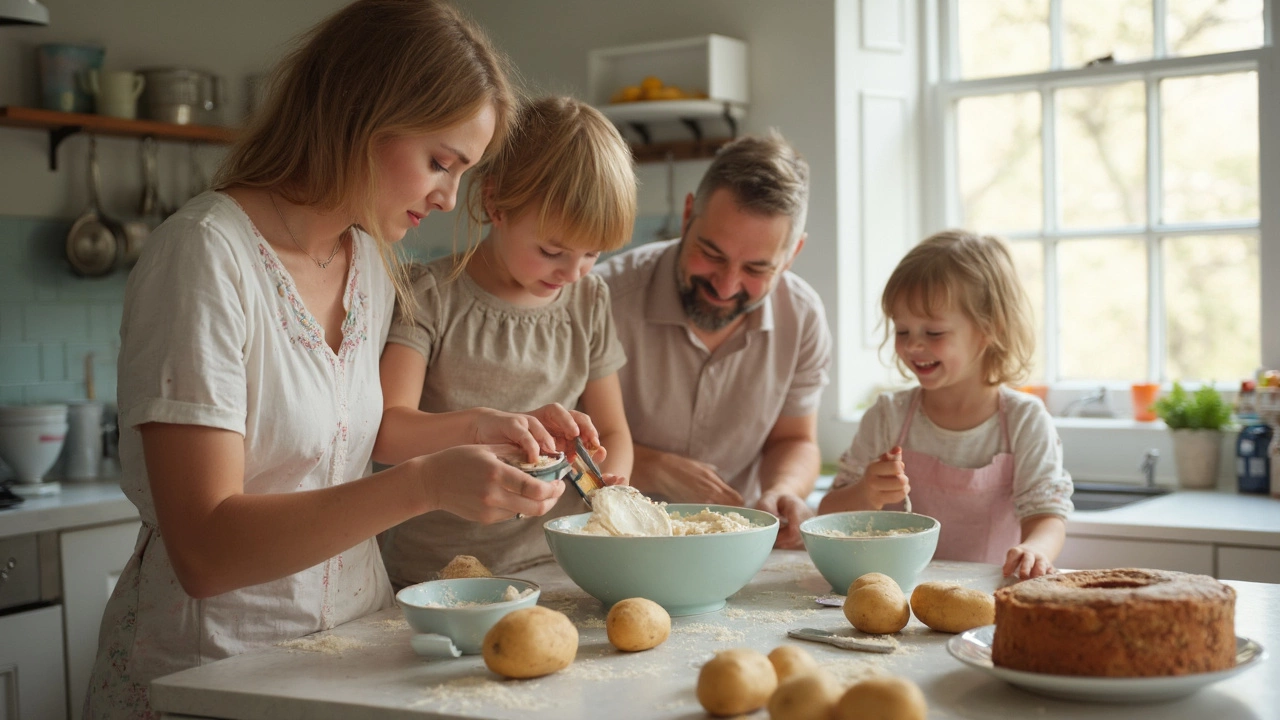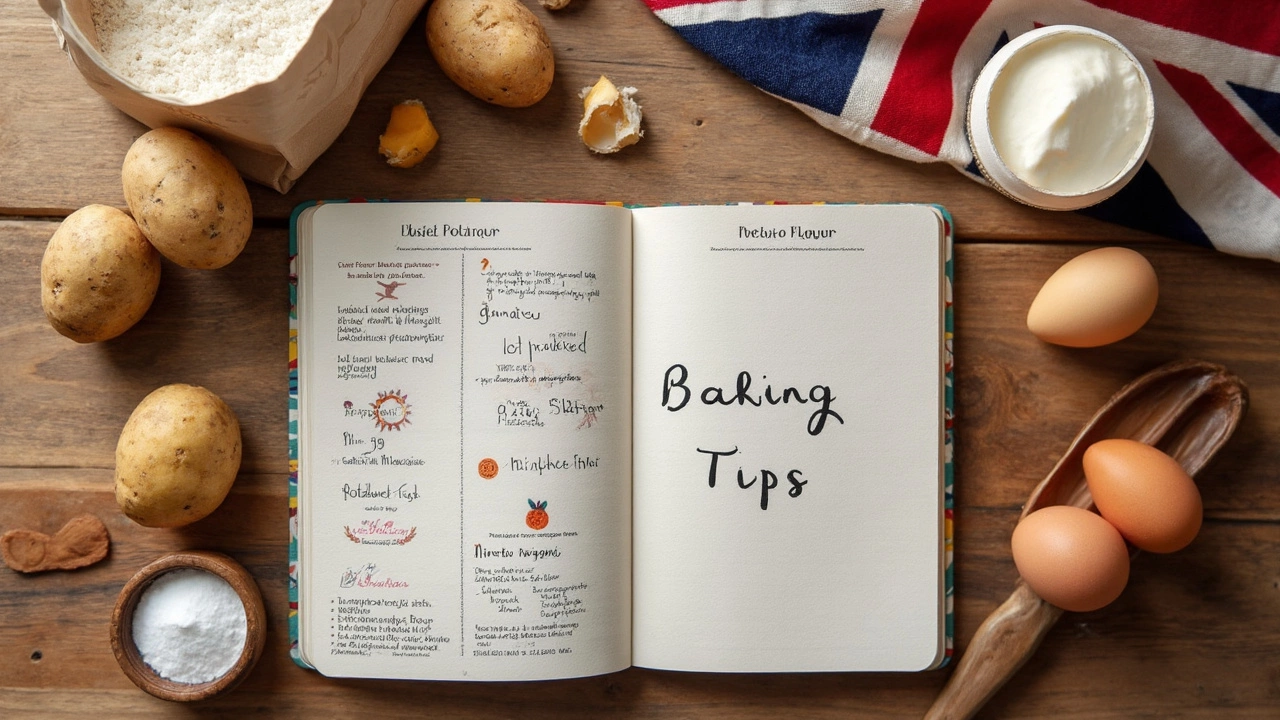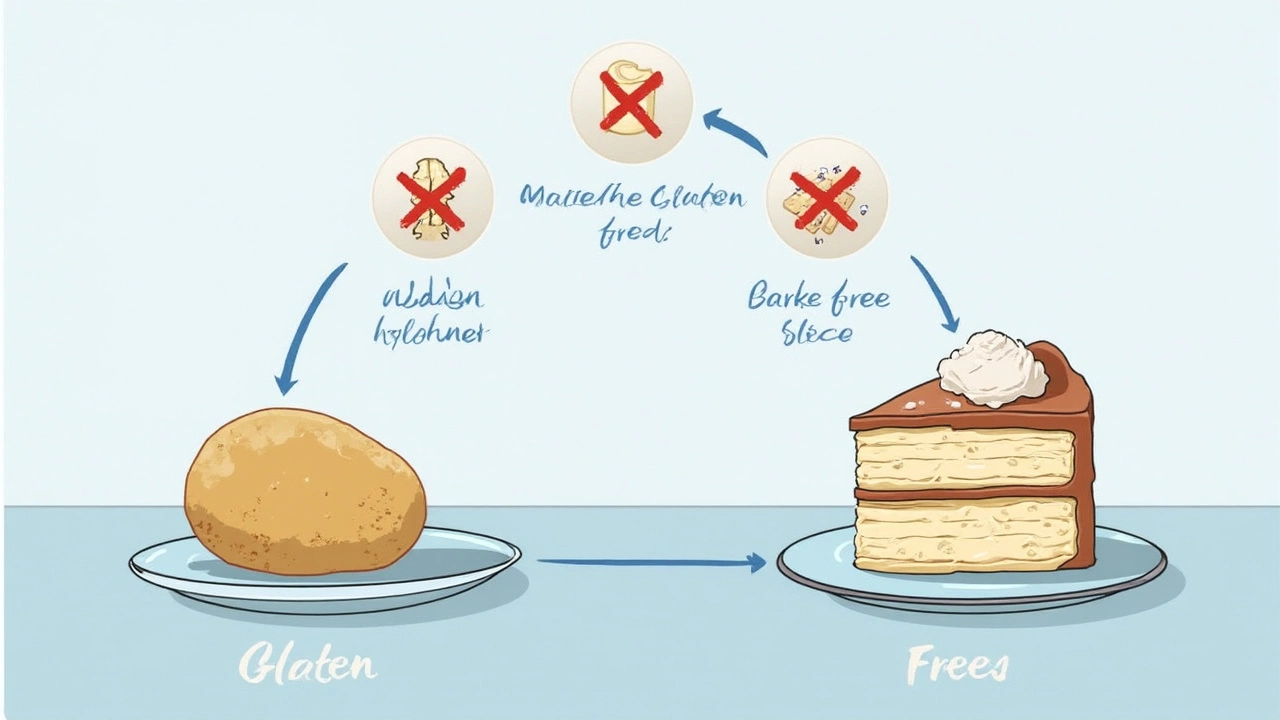
Potatoes are safe if you need to avoid gluten—yep, the simple spud itself doesn’t contain any gluten at all. Whether it’s a russet, red, or Yukon gold, you’re good to go. It’s the sneaky extras that can trip you up, especially once you start turning potatoes into other ingredients like flour or starch. So, if you’re thinking about gluten-free cakes and looking for something besides classic wheat flour, potatoes open up more doors than you might think.
The real catch? Cooking methods matter. Plain, whole potatoes—baked, boiled, or mashed on their own—are always gluten-free. But if you’re grabbing potato flour off the store shelf or tossing in pre-shredded potatoes, double-check for anything added (sometimes, there’s flour or seasonings that aren’t safe). Read the label every time. Just because the base is potato, doesn’t mean it’s totally risk-free if you have celiac or a strong gluten intolerance.
- Are Potatoes Naturally Gluten-Free?
- Hidden Gluten: Where Problems Start
- Potato Flours and Starches in Baking
- Best Tips for Potato-Based Gluten-Free Cakes
- Common Mistakes and How to Fix Them
Are Potatoes Naturally Gluten-Free?
If you ever stress about whether you can eat potatoes on a gluten-free diet, here’s your answer: yes, they are naturally safe. Potatoes are vegetables, not grains. They grow underground and have nothing to do with wheat or any gluten-containing grains like barley or rye. This means you can use any regular potato as a base in gluten-free cakes or other dishes with zero worries about hidden gluten in the potato itself.
Here’s an easy breakdown to see what’s what:
- All types of potatoes are gluten-free. This includes russets, reds, Yukon golds, new potatoes—whatever you like.
- A regular potato contains just potato. No grains or wheat sneak into its makeup.
- Freshly cooked potatoes from scratch are always gluten-free.
You might be surprised to hear how common potatoes are in gluten-free cooking. You can mash them, shred them, or even bake cakes with potato flour or starch. Some gluten-free cake mixes even use potato flour as a main ingredient because it keeps things light, moist, and tender—something gluten-free bakers know is pure gold.
| Food | Gluten Content |
|---|---|
| Whole Potato (any type) | Gluten-Free |
| Sweet Potato | Gluten-Free |
| Wheat Flour | Contains Gluten |
| Potato Flour | Gluten-Free (if pure) |
If you’re going gluten-free, potatoes give you so much flexibility in baking and cooking. Just remember, the potato itself is never the issue—the trouble only starts with what’s mixed in or added later (like when potato salads get a dose of wheat-based thickeners). With plain potatoes, you’re totally safe and set to get creative in the kitchen.
Hidden Gluten: Where Problems Start
This is where people often get tripped up. Gluten-free doesn't always mean what you hope when it comes to potatoes in baked goods. The main risk isn’t the potato itself—it’s all the stuff added or the cross-contact during prep, especially in packaged foods or processed potato products.
If you buy store-bought mashed potatoes, frozen hash browns, or potato flour, you’re looking at a higher risk for added gluten. Sometimes manufacturers use wheat flour to thicken or coat. And with anything made in a factory that works with wheat, even a tiny bit of dust can ruin things for someone with a gluten issue. Always read those ingredient labels line by line. Look for warnings like “may contain wheat” or “processed in a facility that handles gluten.”
If you’re thinking of using potato flour or potato starch for gluten-free cakes, here’s the thing: potato starch is usually just pure starch, so that’s safe for most people. Potato flour, though, is made from whole potatoes (skin and all) and has a different taste and texture. Buy from brands that clearly mark their products gluten-free, not just “wheat-free.”
"Even though potatoes are naturally gluten-free, they can pick up gluten through shared equipment or added ingredients, so vigilance is important," says the Celiac Disease Foundation.
Here are some common problem spots when baking with potatoes:
- Instant potato mixes: Many have wheat-based thickeners, unless they say gluten-free on the front.
- Restaurant fries: Even pure potato fries get fried in oil with things like battered onion rings—hello, cross-contact.
- Pre-seasoned or flavored potato products: Spice blends, coatings, or sauces can hide gluten.
- Baking mixes: Cake mixes labeled "potato-based" sometimes contain wheat flour unless certified gluten-free.
If you’re not sure about a product, check a trusted gluten-free list online or call the company directly. Don’t let marketing fool you just because it says “potato” in big letters.

Potato Flours and Starches in Baking
If you’re baking gluten-free cakes, you’ve probably seen both potato flour and potato starch in recipes. They sound similar, but don’t get them mixed up. Potato flour is made from whole, dried potatoes. It’s dense, has a strong earthy flavor, and can hold a lot of moisture. Potato starch, on the other hand, is just the pure starch extracted from potatoes—no flavor, all the thickening power, and super light in texture.
Why do both show up in gluten-free recipes? Potato flour adds bulk and keeps cakes from turning into a crumbly mess, while potato starch lightens up the texture so things don’t end up gummy or heavy. If you swap one for the other, your results won’t turn out right. Some baking mixes use both just to get the right texture.
Here’s where things get real: both potato flour and potato starch are gluten-free by nature. The trouble starts during packaging and processing. Factories sometimes handle wheat or other grains, which can lead to cross-contamination. Always pick brands that clearly say "gluten-free" on the label—Bob’s Red Mill and King Arthur are two brands that test for gluten cross-contact.
Want to know how these stack up compared to other gluten-free flours? Check this table for a quick comparison:
| Type | Main Use | Texture | Adds Flavor? |
|---|---|---|---|
| Potato Flour | Moisture, Bulk | Dense, Heavy | Yes (Earthy) |
| Potato Starch | Lightness, Thickening | Light, Silky | No |
| Rice Flour | Bulk | Slightly Gritty | No |
One last tip: potato starch is great for giving cakes that soft, fluffy feel. Try blending it with other gluten-free flours like almond or rice for the best texture. Don’t use just potato flour alone—it’ll make your cakes dense and maybe even a little wet in the middle.
Best Tips for Potato-Based Gluten-Free Cakes
If you’re looking to create a gluten-free cake that’s actually moist and doesn’t taste like cardboard, potatoes might surprise you. Using potato starch or mashed potatoes in your recipe bumps up the texture and helps cakes stay soft—something many gluten-free bakes sorely lack. Here’s what you want to keep in mind:
- Start with the right potato product: Potato starch is different from potato flour. Starch is a super-fine white powder, perfect for adding lightness. Potato flour is heavier and should only be used in small amounts. Too much makes your cake gummy.
- Balance your flours: Mixing potato starch with other gluten-free flours like almond or rice flour gives you better structure. All-potato cakes usually turn out too dense.
- Don’t skip the binder: Because you’re baking without gluten, you need help holding things together. A little xanthan gum or psyllium husk goes a long way.
- Add moisture boosters: Potato-based cakes benefit from extra moisture. Try adding applesauce, yogurt, or even a bit of mashed sweet potato for extra softness.
- Watch the bake time: Cakes with potatoes can bake a little faster, especially if you’re using starch. Check 5-10 minutes before you’d normally expect them to be done.
For people with celiac or a high sensitivity, double-check your baking powder and other mix-ins; sometimes these contain hidden gluten. And always mix batter gently—over-mixing can make potato starch cakes tough instead of tender.
If you’re curious how potato-based gluten-free cakes stack up against others, here’s a quick comparison:
| Baking Ingredient | Texture | Common Uses |
|---|---|---|
| Potato Starch | Light, fluffy | Cakes, breads, cookies |
| Potato Flour | Dense, moist | Bread, dense cakes |
| Rice Flour | Crumbly, dry | Cakes, cookies |
So, next time you’re baking gluten-free cakes, let potatoes do some of the heavy lifting. Little tweaks go a long way when you want dessert that feels just as good as the "real" thing.

Common Mistakes and How to Fix Them
It’s easy to think anything made from potatoes is safe for a gluten-free diet, but there are a few classic slip-ups to watch for when baking gluten-free cakes or getting creative in the kitchen.
- Assuming Everything Potato-Based is Gluten-Free: Potato chips, mixes, or ready-made potato flours often sneak in wheat flour or barley-based seasonings. Always check the label—even on stuff you’ve bought before. Brands change ingredients without warning.
- Using Shared Kitchen Equipment: Cross-contact is real. If your mixer, baking pans, or whisks saw regular flour last week, clean them thoroughly or use separate ones for gluten-free baking. Even a few crumbs can ruin the whole thing for someone with celiac.
- Choosing the Wrong Potato Flour: Potato flour and potato starch sound similar but bake up very differently. Potato flour is heavier and can make cakes gummy if you use too much. Potato starch is lighter and gives a fluffier crumb. They’re not always interchangeable.
- Not Blending Flours: Relying on 100% potato flour usually leads to dense, heavy cakes. Mix it up with other gluten-free flours, like rice or almond. A typical blend is roughly 60-70% lighter flour and 20-30% potato starch/flour for better texture.
- Forgeting to Check Baking Powder: Some baking powders have hidden gluten, so go for ones clearly labeled gluten-free. This trips up more bakers than you’d think.
If you’ve already had a cake disaster, here’s how to troubleshoot:
- Dense Cake: Next time, use less potato flour and add a bit more liquid. Try sifting your flours for extra lift.
- Crumbling Texture: Add a teaspoon of xanthan gum or psyllium husk to help hold things together without gluten.
- Gummy Layers: Cut down on the potato flour, switch to a blend, or bake a few minutes longer at a slightly lower temperature.
Here’s a quick comparison to help you keep your ingredients straight:
| Ingredient | Is It Gluten-Free? | Best Use in Cakes |
|---|---|---|
| Whole Potatoes | Yes | Add moisture, dense texture |
| Potato Starch | Yes (if labeled) | Light crumb, blends well |
| Potato Flour | Yes (if labeled) | Structure, thicker batters |
| Pre-mixed Potato Products | Check label | Varies |
Swapping and combining the right ingredients makes all the difference. Don’t assume anything and label everything—your next gluten-free cake will taste and feel way better for it.